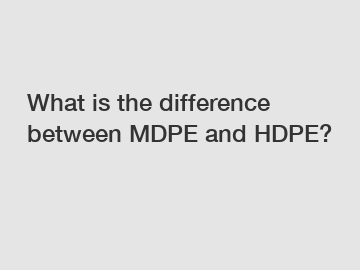What is the difference between MDPE and HDPE?
What is the difference between MDPE and HDPE?
MDPE (Medium Density Polyethylene) and HDPE (High Density Polyethylene) are both forms of polyethylene, a commonly used plastic material. They have various similarities and differences, which make them suitable for different applications. Let's delve into the details to understand the dissimilarities and applications of MDPE and HDPE.
1. Density:

MDPE and HDPE differ in terms of their density. As the name suggests, MDPE has a medium density, ranging between 0.926 and 0.940 g/cm3. On the other hand, HDPE has a high density, typically ranging between 0.941 and 0.965 g/cm3. The higher density of HDPE makes it more rigid and durable compared to MDPE.
2. Melt Index:
Another distinguishing factor between MDPE and HDPE is their melt index. The melt index, denoted in g/10 min, is a measure of the flowability of the polymer during the melting process. MDPE generally has a higher melt index than HDPE. This means that MDPE has a higher flowability and is easier to process using methods like injection molding and extrusion.
3. Chemical Resistance:
Both MDPE and HDPE exhibit excellent chemical resistance properties. They are resistant to a wide range of chemicals, including acids, alkalis, and hydrocarbons. However, HDPE has better resistance to certain chemicals like oxidizing agents and aromatic hydrocarbons. This makes HDPE more suitable for applications involving contact with aggressive chemical substances.
4. Strength and Durability:
Regarding strength and durability, HDPE has an upper hand over MDPE due to its higher density and crystalline structure. HDPE possesses better tensile strength, impact resistance, and stiffness compared to MDPE. Therefore, HDPE is often used in applications that require robust materials that can withstand heavy loads, such as pipes, tanks, and construction materials.
5. Flexibility:
On the other hand, MDPE offers better flexibility and elongation properties compared to HDPE. This makes MDPE ideal for applications requiring materials that can be easily bent or twisted, such as tubing, irrigation systems, and medical devices. Additionally, MDPE is more resistant to stress cracking, allowing it to withstand the rigors of underground installations.
6. Applications:
MDPE and HDPE find applications in a diverse range of industries. Here are a few examples:
- MDPE: Due to its flexibility and stress-crack resistance, MDPE is commonly used for gas and water pipes. It is also used in irrigation systems, geomembranes for soil protection, and as a protective layer for electrical cables.
- HDPE: The rigid and durable nature of HDPE makes it suitable for various applications. It is widely used in the construction industry for water and sewage pipes, geomembranes for landfill liners, and as a material for tanks and containers. HDPE is also utilized in the packaging industry for bottles, crates, and bags.
In conclusion, MDPE and HDPE differ in terms of their density, melt index, strength, flexibility, and chemical resistance. MDPE is more flexible and has a higher melt index, while HDPE is stronger and more rigid. Both materials offer exceptional chemical resistance, albeit with differences in specific chemical compatibility. Choosing between MDPE and HDPE depends on the requirements of the application at hand, with MDPE being suitable for situations that demand flexibility, and HDPE being favored for its strength and durability.
Contact us to discuss your requirements of Dredge Pipe Floats, hdpe conduit for sale, HDPE Dredging Pipe Floaters supplier. Our experienced sales team can help you identify the options that best suit your needs.
151
0
0


Comments
All Comments (0)